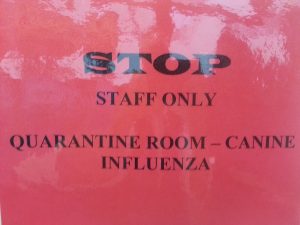Module 5: Management and Prevention of Disease Outbreaks
Quarantine of Exposed Animals
The benefit of isolating sick animals for disease containment is undermined if asymptomatic exposed animals remain in the general population. Exposed animals may not yet be ill because:
- They are in the preclinical incubation period of infection
- They have a subclinical infection
- They were not exposed to a high enough dose of the pathogen to become infected
- They are not infected due to immunity
Because their infection status is unknown, all exposed animals, either by direct contact or fomite contact, are considered an infectious risk and quarantined to protect other animals from exposure. Ideally, the exposed animals should be consolidated to a housing area that is physically separated from other areas where unexposed animals are housed.
The quarantine time is equal to the pathogen’s maximum incubation period. There should be no animals in and no animals out until the quarantine period expires or infection status is determined by diagnostic testing.
Pathogen Incubation Periods
| Pathogen | Incubation period |
|---|---|
| CDV | 2 wk |
| H3N8 CIV | <1 wk |
| H3N2 CIV | <1 wk |
| CnPnV | <1 wk |
| CPV | ≤10 days |
| FPV | ≤10 days |
| FHV | ≤1 wk |
| FCV | ≤1 wk |
| M. canis (ringworm) | ≤2 wk |
| Strep zoo | ≤1 wk |

The short incubation period for the canine and feline respiratory and parvoviral pathogens contributes to the feasibility of implementing a quarantine for most shelters. The longer quarantine period of 2 weeks for CDV may not be manageable for some shelters.
Quarantined animals should be monitored twice daily for clinical signs. Sick animals should be promptly moved to isolation and the quarantine clock re-started for the remaining animals since there was a new exposure. Re-starting the quarantine clock with each new exposure results in much longer stays in quarantine.
An effectively conducted quarantine can save lives, boost staff morale, build a positive image for the shelter, and enlist public support. However, one of the foremost challenges of quarantining exposed animals in the shelter is the enormous strain it places on housing capacity and staff, especially when the quarantine periods are extended for weeks. In addition to the segregated housing for sick animals and for exposed animals, the shelter still needs somewhere to house unexposed animals and animals that must be admitted during the outbreak response. Is there a way to relieve this strain on housing capacity and staff by releasing animals from quarantine sooner?

